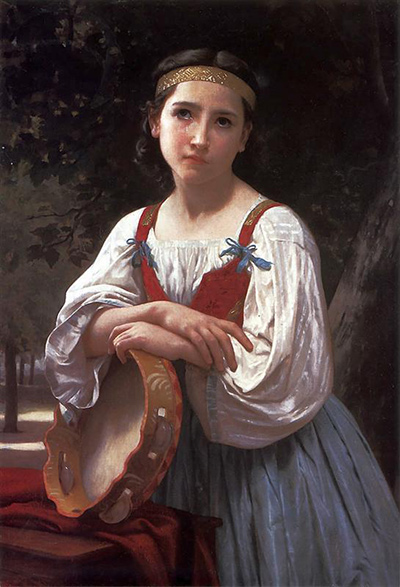Gypsy Girl With a Basque Drum is an 1867 painting by William-Adolphe Bouguereau. It depicts a young gypsy girl posing with her musical instrument beside her, at rest.
The most striking thing about this work is the contrast between what the viewer expects to see and what is actually depicted.
The traditional depiction of gypsies in art and culture of this time was very carefree and fun, to the point of being commonly associated with debauchery and excess.
On the surface, the girl in this painting fits this paradigm perfectly. Aside from her expression, everything about the titular gypsy girl suggests merriment and delight.
She is young and pretty, her dress bodice is brightly coloured and adorned with fanciful ribbons, and her skirt and sleeves are full and seem perfectly suited to move with the girl as she twirls about for some dance steps.
Her drum is an instrument of fun and fancy - simple (unlike the upper-class instruments of the nobility like the violin or piano), but perfect for someone who partakes in music for the joy of it and wishes to provide a strong beat for accompanying dancers to follow.
Instead of playing some lively music with her drum, she rests her arm on it and looks somberly into the distance, seemingly contemplating something of considerable import.
She seems almost world-weary, far more so than she ought to be at her seemingly young age. The scene behind her is empty, almost forlorn.
Contrary to the outwardly convivial atmosphere of gypsy culture, she is alone, and not only in the literal sense; whatever is troubling her, she does not seem to be ready to count on family or community support when facing it. Her troubles are her own.
Through this nuanced overall mood, the painting examines the duality of life - and with it, deconstructs our black-and-white view of the people around us. It is easy to assume that others' lives are made up of only the image they project, and that their entire being can be surmised in a glance.
In reality, life is never wholly pleasant nor wholly daunting, and although we all experience these highs and lows for ourselves, we sometimes forget that other people's lives are as complex as our own. Gypsy Girl With a Basque Drum invites us to consider the fact that no matter what a person looks like, their inner life might not match up with that image.




